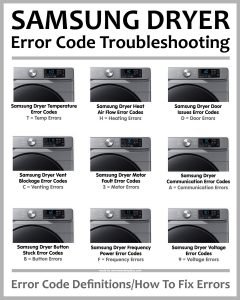
You might be wondering, “Why can’t I just ignore the E3 error? My clothes are drying just fine!” Well, here’s the deal: error codes are there for a reason. They’re a warning sign that something may not be functioning properly, which could reduce your dryer’s efficiency or even damage it over time. So, while the immediate effects might not seem concerning, ignoring it could result in costly repairs or, worse, shorten your dryer’s lifespan significantly. Understanding what the E3 code means can help you determine the best course of action and potentially prevent more serious issues from arising.
Understanding the E3 Error Code
The E3 error code is a specific indicator used by Samsung dryers to point out a problem with the dryer’s sensor. Think of these sensors like referees in a sports game. They keep track of what’s happening inside the dryer — like moisture levels — to ensure that your clothes are dried properly and to prevent overheating. When an E3 error pops up, it means something is amiss with these sensors, indicating they might not be able to perform their job.
One common cause of the E3 error is a malfunction in the moisture sensor. This sensor’s job is to detect when your clothes are dry enough to stop the cycle. If it’s not working correctly, it might lead to overly damp clothes or, conversely, could cause the dryer to overheat. In some cases, the error might be as simple as a bit of lint or debris covering the sensor, disrupting its ability to function effectively. Just as a dirty window restricts your view, lint can prevent sensors from accurately measuring moisture.
Ignoring this error is akin to ignoring a car’s check engine light — it might not feel urgent, but it’s a sign that maintenance is needed. Addressing the E3 error promptly by cleaning the sensor with a soft cloth or seeking professional help to replace a faulty part can save you time and money in the long run. It’s also a good idea to consult your dryer’s manual or Samsung’s customer support for specific troubleshooting steps tailored to your model.
Consequences of Ignoring the E3 Error
You might be asking, “What’s the worst that could happen if I just let it slide?” While it might seem like not much of an issue at first, the consequences of ignoring the E3 error can be surprisingly significant. When your dryer’s sensors aren’t functioning properly, it affects how the machine calculates drying time, potentially leading to longer drying cycles. This doesn’t just waste your time but also hikes up your energy bills. Imagine leaving a light on all night — not just a wasteful habit, but it also adds to your costs over time.
Prolonged ignorance of the E3 error can also pose a risk to your clothes. Since the dryer may not be turning off at the right time, it could over-dry or even damage your clothes. Overdrying can lead to shrinkage, distortion, and wear that shorten the lifespan of your favorite garments. It’s like leaving a cake in the oven too long; even if it’s still edible, it’s not as delightful as it could be.
Furthermore, continuous use of a malfunctioning dryer could accelerate wear and tear on the machine itself. Overheating not only risks your clothes but can also lead to internal damage within the dryer. Parts such as heating elements or sensors might degrade faster, eventually leading to costly repairs or the need for replacement. To avoid these pitfalls, it’s essential to address the E3 error sooner rather than later.
Preventative Measures and Next Steps
Now that you know why the E3 error shouldn’t be ignored, let’s discuss how to prevent it from occurring in the first place. Regular maintenance is key. Just like how routine oil changes keep a car running smoothly, giving your dryer a little TLC helps keep errors at bay. Cleaning the lint filter after every load is a simple step that ensures optimal airflow and sensor accuracy. It’s easy to overlook but highly effective; think of it as the equivalent of wiping your glasses clean for better vision.
If you’ve already encountered the E3 error, the first step is to check the sensor for any obvious signs of obstruction or dirt. A quick clean may resolve the issue. However, if the error persists, consider contacting Samsung support or a professional technician. They can assess whether a sensor replacement is needed or if there are deeper issues at play.
In the future, keeping your dryer in a well-ventilated area and ensuring it sits on a level surface can help prevent many errors. These small actions can make a big difference, much like wearing the right shoes prevents foot pain. By being proactive, you enhance the longevity of your dryer and enjoy peace of mind knowing your appliance is running as efficiently as possible.